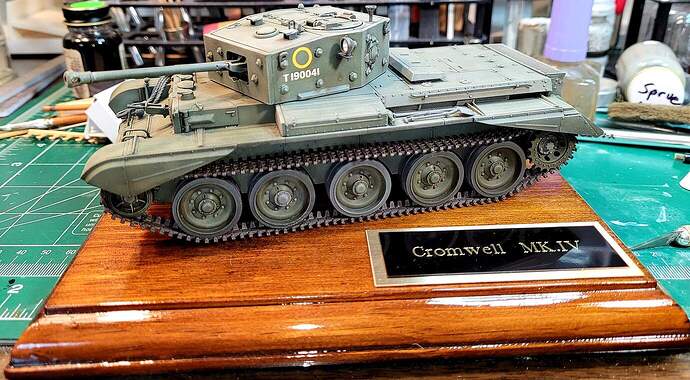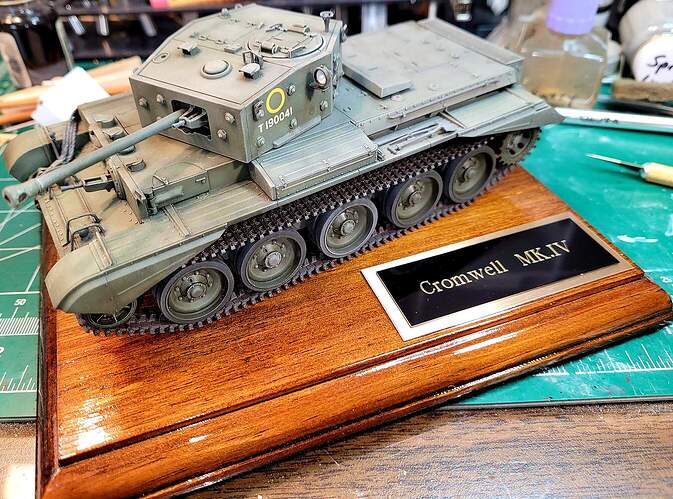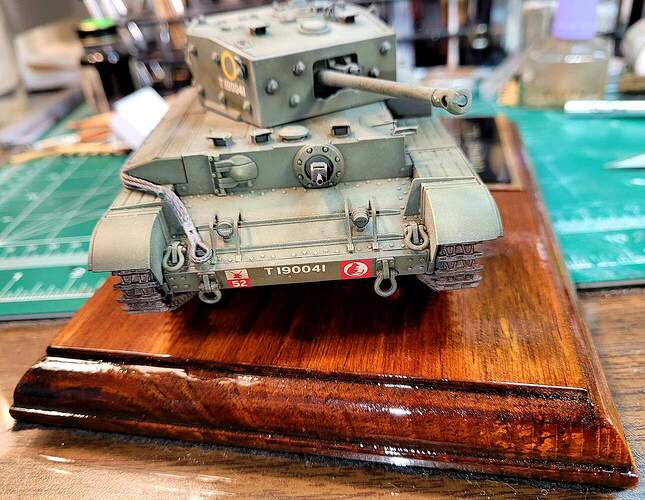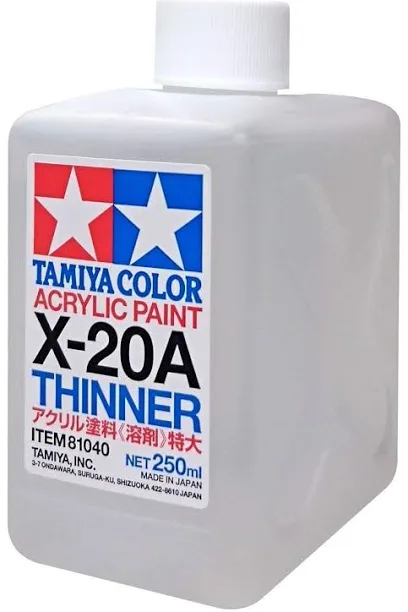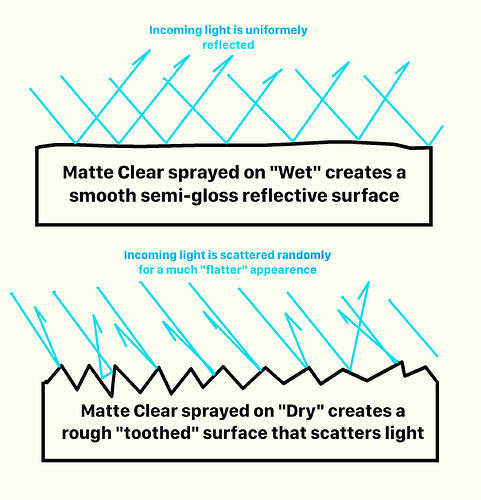Thumbs down for Vallejo flat coat - turns glossy after a while .
FWIW
Speaking of Flat coat turned glossy, once long ago, a Cromwell was put on display at the library with a model club’s display for a year. Cromwell got wet and sat with water on it for a long time. The water soaked areas turned glossy.
The model had been flat coated in Pactra Clear Flat A48 shown above. It’s the only time, I’ve had a cured Flat coat change and go shiny. Put the model aside and let it dry out while trying to figure out a solution to save it.
Here’s the fixed flat coat.
It’s the original Pactra Clear Flat A48 after one brush down in Tamiya A20 acrylic thinner. As soon as the thinner evaporated the gloss issue was fixed. It was fixed over three years ago and still looks the same.
In some cases, if an acrylic flat goes glossy a brush down in this might be able to save the flat coat without a strip and repaint in my experience.
Just depends.
If I’m putting on a matt coat as an intermediate layer (over decals or some initial weathering) then I go with Tamiya. For a final “dead flat” coat, I like Testor’s Dull Coat (aka “Flat Clear Lacquer”). The Tamiya stands up better to my usual weathering and finish methods and materials, so it’s tougher as an early or intermediate layer. Washes will sometimes pull up Dull Coat.
I’ve found that Tamiya clear flat has a very slight sateen / egg shell finish and is not as “dead flat” as the Testor’s Dull Coat. However, sometimes that degree of specularity is desirable, so Tamiya for the final flat coat in those cases. Usually, though, I’m going for a “dead flat” and my final clear is Dull Coat.
One thing that a lot of modeler’s don’t take advantage of, I think, is the way that specularity can be adjusted from high-gloss to dead flat. Subtle differences in sheen can add a lot of understated effect to the finish and weathering. For these variables, I really do like Tamiya since they offer gloss clear, semi-gloss clear, and matt clear - and all three can be mixed to achieve just about any degree of sheen you can think of. (Dull Coat and Gloss Coat can also be mixed, but they’re a bit more “fiddly” to dial in.)
If you are getting a “sheen” out of the Tamiya matte clear (TS-80) then you are spraying it on a bit too wet. Any flat color will develop a sheen when sprayed on heavily and allowed to flow out smoothly.
Note: this rough toothed surface will also hold onto oil pastel pigments very nicely for weathering without further need to top coat.
A further comment on the blotchy clear coat on the Spitfire wing; What Matte Clear are you using??? The Tamiya spray nozzle is designed to create a smaller more finely atomized spray coat than the large “Home Depot” cans so that might possibly be your problem here.
The large economy size cans of flat spray offer no real economies other than sheer volume of paint.
I don’t know if this example helps or not. I hope so.
Matte base color, decals sealed with Future (wet, brushed on both below and above the decal) final top coat of Tamiya Matte Clear (TS-80) followed by a light coat of oil pastel “Dust & Grime”.
I appreciate the assist @165thspc !
I don’t use the rattle can stuff, though. I’m airbrushing XF-86 reduced with Tamiya “yellow cap” lacquer thinner. I’ve been using it along with X-35 Semi Gloss and X-22 for years. (But I’ve been squirting Dull Coat since the early 1970’s… LOL!).
When I said that XF-86 dries with a bit of sheen, that’s only in comparison to Testor’s Dull Coat.
I might use several clear layers as I finish a model - some as fixers, sometimes to mute or blend effects, other times perhaps to “blend the edges” of decals, etc. Just another tool in the ol’ paint box. I might also vary the specular qualities of the finish depending on the intended overall “look” (maybe blending from damp or wet surfaces to dry ones or anything in between).
Another good use for clears is to add “body” to semi-transparent glazes. You can get much, much better, smoother and consistent glazes by adding 10-15% clear to the mix rather than just using excess thinners and a few drops of paint. I actually keep a few different glaze shades pre-mixed and ready to spray.
Anyways…
Well not meaning to over state this, however; perhaps in the case of the Spitfire you should buy a can of the TS-80 and give it another shot.
My opinion is that your paint droplet size is not fine enough, (atomization) and the thinner causes the the large droplets it hit and immediately flow out, giving you blotchy spots of both rough (matte) areas and spots of semi-gloss (smooth) areas in the matte paint.
I use either Tamiya or Gunze. I prefer the Gunze and use Tamiya thinner with it. never had an issue.
i used testors lacquer dullcote clear in the rattle can. the tamiya i am concerned it would ruin the decals. i use testors over decals on my cars for the same reason. i had been told the tamiya gloss clear is hotter and could ruin a cars decals.
thanks for that. can you do that with gloss too?
Sure! But for gloss clear you just spray the Holloway House Quick Shine straight, no additives or thinning. It will give you a beautiful shine.
